- Blog
- 14 Conversion Rate Optimization Best Practices You Need to Know in 2025
14 Conversion Rate Optimization Best Practices You Need to Know in 2025
-
Nikolett Lorincz
- Conversion
- 6 min read
Table of Contents
Conversion rate optimization is a must-have tool for ecommerce marketers who want to unlock the full potential of their website and transform more visitors into paying customers.
In this article, we’ll explore 14 conversion rate optimization best practices that can help you gain a competitive advantage in the market in 2025.
But first, let’s define conversion rate optimization!
What is conversion optimization and why does it matter?
Conversion rate optimization (CRO) is the process of increasing the rate of website visitors who complete a desired action (e.g. making a purchase or completing a form).
Conversion optimization is important as it allows you to get the most out of your current website traffic. Plus, working on your conversion funnel can potentially double the number of leads and customers you get without spending more money on ads and without increasing traffic.
That’s something that all ecommerce store owners want to achieve. And to do it, all you need is a well-executed conversion optimization project for significant improvements in your conversion rate.
It sounds easy, but in practice, the optimization process is continuous hard work. Luckily there are some strategies you can implement quickly to boost your marketing efforts.
Some examples are:
- Speaking to customers and tailoring marketing materials according to their feedback
- Minimizing friction for sign-ups
- Improving the user experience
- Optimizing content for the search engine results page (SERP)
These are just a few examples of strategies you can implement as part of a CRO strategy. Keep reading for more actionable strategies.
What is a good conversion rate?
Before diving into the strategies, let’s discuss what counts as a good conversion rate.
A good conversion rate varies depending on factors such as:
- industry,
- niche,
- and audience demographics.
For instance, the typical ecommerce conversion rate is between 1.84% and 3.71%, while the average conversion rate is higher in B2B, between 2.35% and 4.31%.
These rates can serve as a general benchmark for you to aim for when optimizing your website.
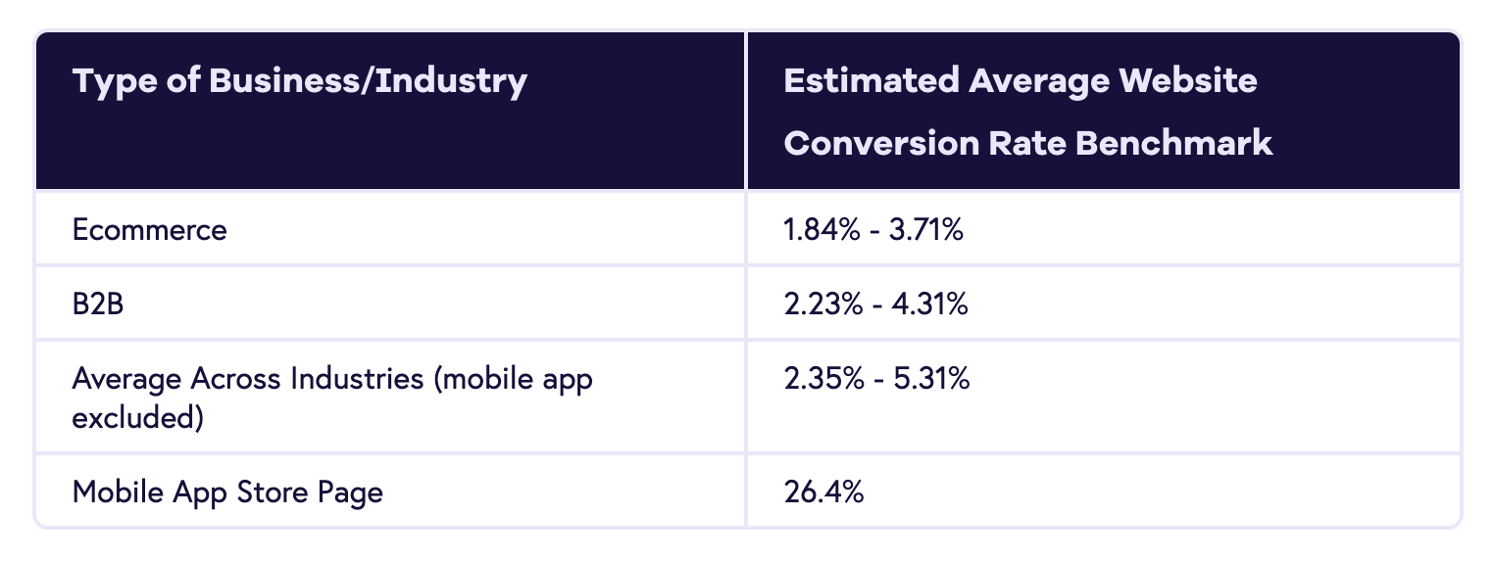
Source: Geckoboard
Recommended reading: 27 Ecommerce Conversion Rate Optimization Statistics You Need to Know
14 conversion rate best practices
Want to stay current and adopt the most recent conversion rate optimization (CRO) best practices to prosper?
Watch this video for tested strategies that can boost your revenue:
Now let’s check out our list of best practices that will help to increase your conversion rates!
1. Understand your users
Understanding your users means conducting both qualitative and quantitative research to identify their needs, pain points, and behaviors.
This involves using various tools and methods:
- Surveys: Design surveys to gather feedback on user preferences, challenges, and satisfaction levels.
- Interviews: Conduct one-on-one interviews to dive deeper into user motivations and experiences.
- Feedback tools: Utilize tools like feedback forms, chatbots, and social media to collect real-time user opinions.
Analyze this data to identify common themes and insights. Create user personas and journey maps to visualize user behavior and preferences.
This user-centric approach helps in designing tailored experiences that address specific user needs, leading to higher engagement and conversion rates.
By putting your users at the center of your optimization efforts, you can create experiences that truly resonate with them and address their specific issues.
2. Craft a clear value proposition
Developing website copy with a clear value proposition is a fundamental component in website optimization to convert visitors. It communicates the unique benefits of your product or service to potential customers, effectively demonstrating how your offering is the most effective solution to their needs.
To craft a compelling value proposition, you should follow these steps:
- Identify your target audience and understand their needs, pain points, and desires.
- Identify what sets your product or service apart from the competition.
- Clearly articulate the benefits your product or service provides.
- Use simple language without unnecessary jargon.
- Use a customer-centric approach.
- Be specific about what makes your product or service unique.
- Gather feedback and iterate based on it to ensure your value proposition resonates with your audience.
As part of your optimization efforts, don’t forget to regularly revisit your value proposition to ensure it remains relevant.
3. Write engaging, benefit-driven headlines and copy
Another vital component in optimizing your website for more conversions is writing engaging, benefit-driven headlines and copy on all your pages, including your homepage, category pages, and product pages.
Optimizing landing pages with engaging headlines and copy is crucial to increase conversions.
When crafting your headlines, make sure that they:
- Grab attention
- Present a clear value proposition
- Are specific
- Evoke an emotional response
- Are action oriented
- Utilize numbers
Warby Parker’s homepage provides a great example of an engaging, benefit-driven headline. The headline “Try 5 frames at home, for free” is specific, action oriented, and presents a clear benefit.

4. Use testimonials and social proof
Incorporating testimonials and social proof is a powerful strategy for building trust and credibility with site visitors.
There are several types of social proof that can be used for conversion rate optimization, including:
- Customer testimonials
- User-generated content
- Case studies
- Reviews and ratings
- Influencer endorsements
- Social media followers
By showcasing the experiences and opinions of satisfied customers, you can instill confidence in your offerings.
It’s also important not to bury those awesome testimonials you have at the bottom of a product page. Instead, try adding a positive testimonial to the above-the-fold section like Vegetology did.
This helps website visitors quickly gain a deeper understanding of the product and see that other people have had positive experiences with it.
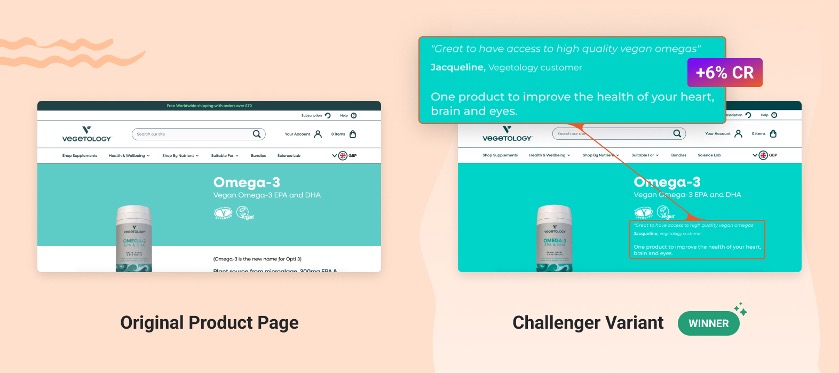
5. Simplify your forms and CTAs
Simplifying forms and CTAs (calls-to-action) is an effective approach to boost your conversion rate optimization efforts. Clear and concise CTAs help guide site visitors toward the desired action.
When designing clear and effective CTAs, it’s important to:
- Use language that encourages action
- Ensure the CTA is in line with the context and content of the website or landing page
- Optimize the design and placement of the CTA to make it stand out visually
6. Make data-driven decisions instead of relying on gut feelings
Making decisions based on data should be a key part of every CRO strategy.
By relying on actual user behavior and preferences rather than intuition, you can make informed decisions that lead to higher conversion rates and increased revenue.
Utilizing tools such as Google Analytics and Hotjar can help you gather and analyze valuable data about visitor behavior and preferences.
You can also rely on user feedback to collect more information about the website experience and understand user behavior.
In the example below, you can see how Flip used a survey popup to collect information about why people aren’t ordering their service.
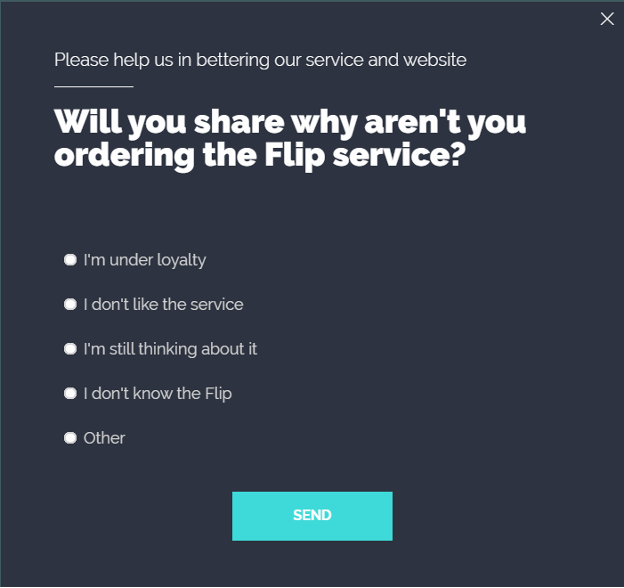
7. Shorten the checkout process
Shortening the checkout process is imperative if you want to increase the number of conversions.
A lengthy or complicated checkout process can be a significant barrier for potential customers, leading to cart abandonment and lost sales. In fact, a too-long/complicated checkout process is the reason behind 17% of lost sales!
To optimize the checkout process, consider simplifying things, providing guest checkout, and offering multiple payment options.
Bubble Skincare’s single-page checkout process is a good example:
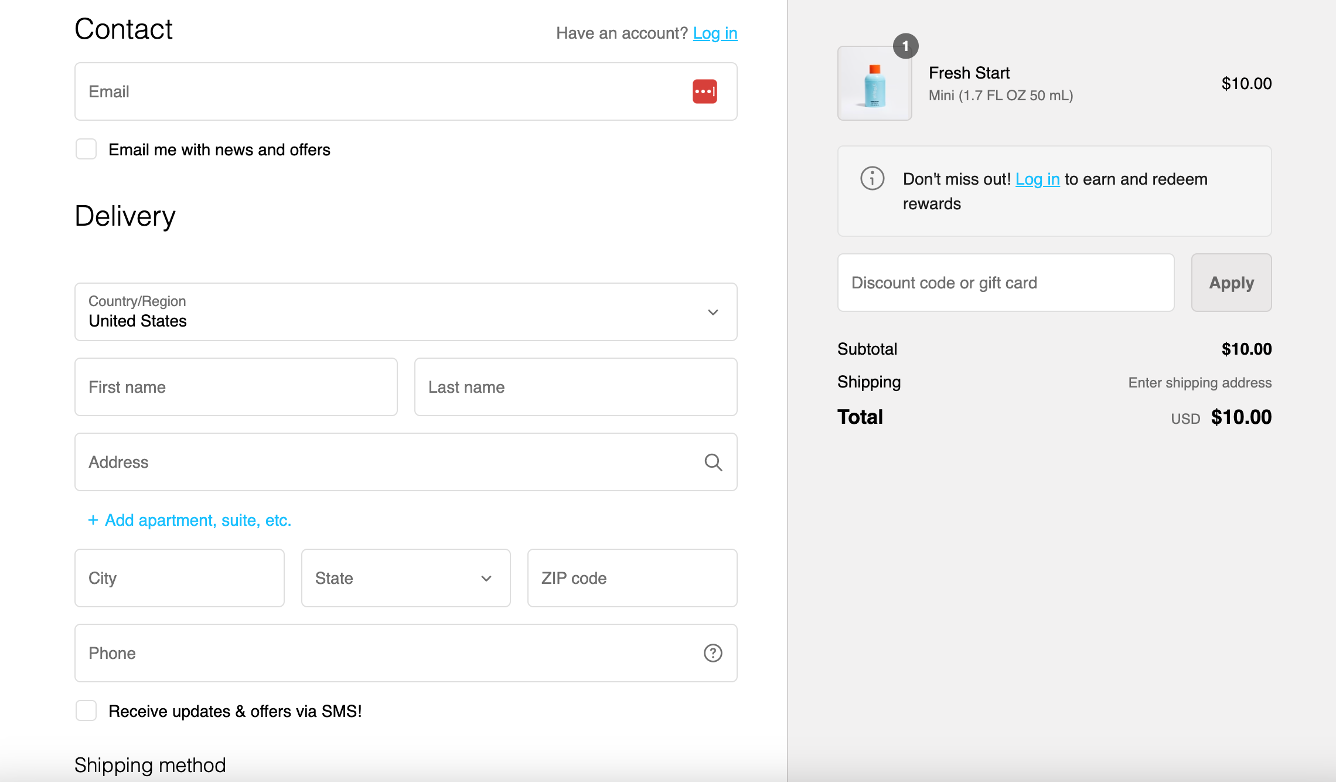
If you want to improve your checkout process, here are 16 best practices.
8. Continuously run A/B tests
A critical aspect of refining your website’s performance and enhancing user engagement is the consistent implementation of A/B tests.
By pitting two versions of a web page or element against each other, you can gauge which variant elicits a higher conversion rate. This empirical approach empowers you to make informed choices regarding design and content elements that resonate best with your target audience.
Here’s how you can get started with A/B testing (also called split testing):
- Select an A/B testing tool
- Establish goals and hypotheses
- Focus on tests with a high potential impact
- Carry out tests regularly
- Iterate and optimize continually
Running constant A/B tests can eat up a lot of time, but recent advancements in AI have introduced automation to streamline the process.
OptiMonk’s Smart A/B Testing feature is at the forefront of this innovation, leveraging advanced technology to automate 99% of your tasks.
By conducting parallel tests on each element of your landing page, this tool ensures efficient and rapid experimentation, allowing you to stay ahead in the competitive online landscape.
This tool will automatically generate alternative headlines for you to test against your original headline. You can easily modify or delete these as needed.
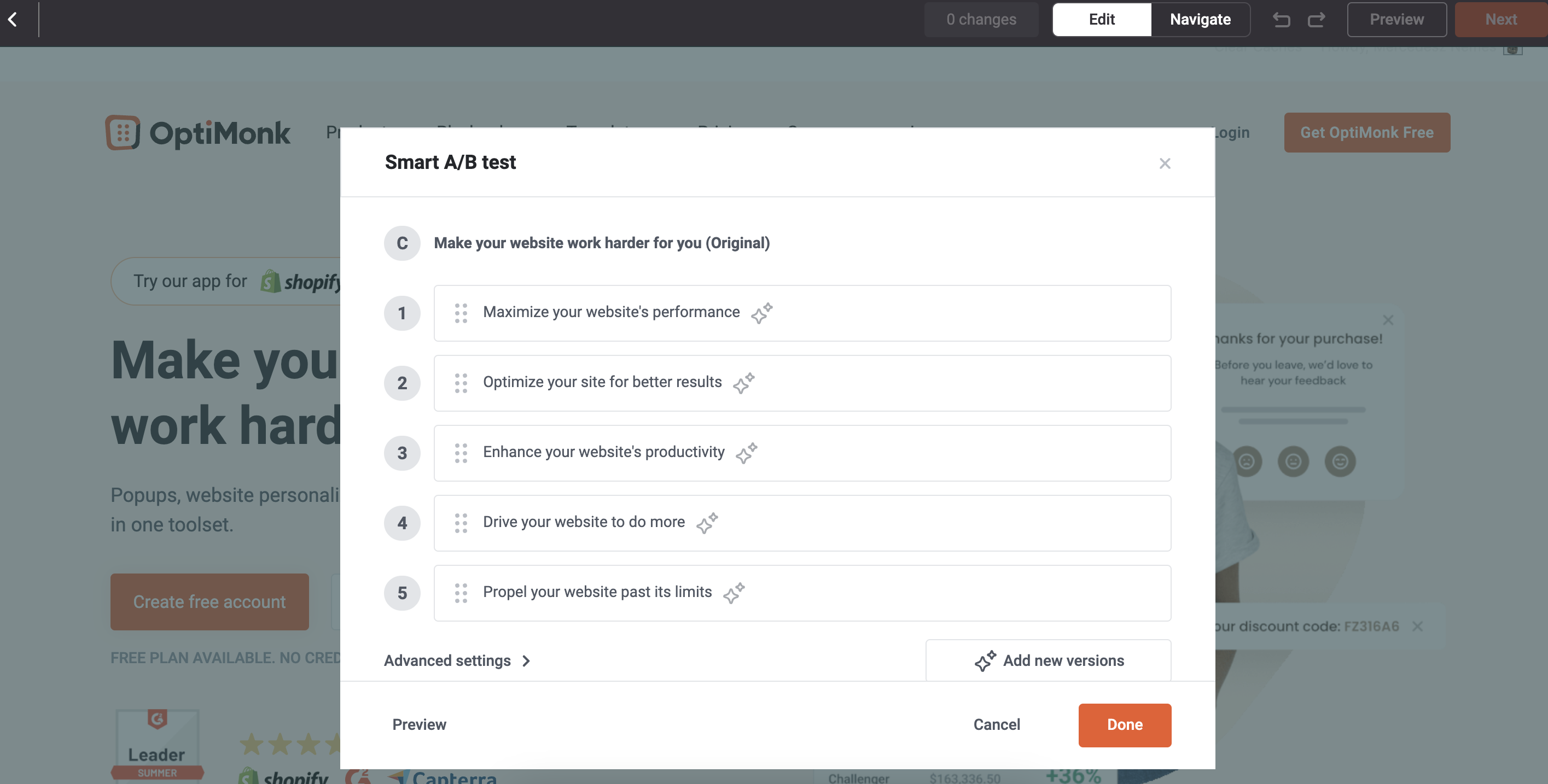
Wanna learn more about it? Check out this guide on how to set it up.
9. Implement a systematic approach
A systematic approach to conversion rate optimization involves prioritizing testing ideas and conducting regular experiments.
Here are the key steps to achieve this:
- Prioritize testing ideas: Use methods like ICE (Impact, Confidence, Ease) to score and rank your testing ideas. This helps you focus on experiments that have the highest potential impact with manageable effort.
- Develop clear hypotheses: For each test, create a clear hypothesis that states what you expect to happen and why. This provides a foundation for analyzing the results and understanding the outcomes.
- Regular A/B testing: Conduct A/B tests regularly to compare different versions of a webpage or element. Ensure you have a sufficient sample size for reliable results. Use tools like OptiMonk or Optimizely to manage these tests.
- Analyze results: After each test, thoroughly analyze the results. Look at both quantitative metrics (e.g., conversion rates, click-through rates) and qualitative feedback to understand user behavior and preferences.
- Iterate based on findings: Use the insights gained from your analysis to inform future experiments. This iterative process of testing, learning, and optimizing ensures that your decisions are data-driven and continuously improving.
10. Re-engage abandoning visitors with exit popups
Exit-intent popups are one of the best CRO tools out there as they’re a powerful way to re-engage visitors who are about to leave your website.
By presenting a compelling offer or message just before the visitor exits the page, you can capture their attention and encourage them to complete their purchase or sign up for an email list.
If you want to design effective exit popups, you can get started with one of these ready-to-use templates:
11. Build your email list with popups to support conversions
Leveraging popups to build an email list is a tried-and-true strategy that can significantly boost conversions.
To effectively implement this approach, it’s crucial to focus on providing value to your potential buyers.
Consider incorporating popups that offer something your audience wants, such as exclusive discounts, informative ebooks, or access to premium content.
By giving website visitors a compelling reason to share their email addresses, you not only expand your subscriber base but also create a pool of engaged users who are more likely to convert in the future.
12. Create urgency and scarcity
Creating urgency and scarcity is a powerful tactic for driving sales and increasing conversions.
The psychology behind these elements taps into the fear of missing out (FOMO) and the desire to secure something valuable before it’s gone.
Implementing limited-time offers and countdown timers in your marketing strategy can prompt visitors to take swift action. The fear of losing out on a special deal or a product in high demand triggers a sense of urgency, compelling visitors to make quicker decisions.
13. Offer diverse payment options
Providing a variety of payment options is crucial when it comes to meeting a wide range of customer preferences and increasing the probability of conversions.
By providing customers with multiple payment options, you ensure that visitors can utilize their preferred payment method.
Some of the most commonly utilized online payment methods are expected to include mobile wallets (digital wallets for mobile devices such as Apple Pay and Google Pay) and traditional payment processors like PayPal.
14. Optimize your product pages
Product page optimization is vital for driving conversions and securing your website’s success. By using high-quality images, providing detailed descriptions of product features, and including customer reviews, businesses can furnish visitors with all the information they need to make a purchase decision.
To optimize your product pages, consider the following best practices:
- Craft compelling product descriptions that highlight key features and benefits.
- Write persuasive headlines that help customers immediately understand the benefits.
- Add a positive customer testimonial at the top of your product pages to build trust with customers.
- Utilize bullet points to make information easy to scan and digest.
- Refine your keyword strategy to improve search engine visibility.
- Design headers or banners to strengthen branding and create a cohesive visual experience.
Varnish & Vine‘s conversion rate optimization program proves how important optimizing product pages is.
The Varnish & Vine team had been using the product names as the main headline and didn’t really offer any other useful information in the above-the-fold section. They decided to add new headlines and benefit lists to their product pages.
They used OptiMonk’s Smart Product Page Optimizer to craft captivating headlines, subheadlines, and lists of benefits for each product page and update them automatically.
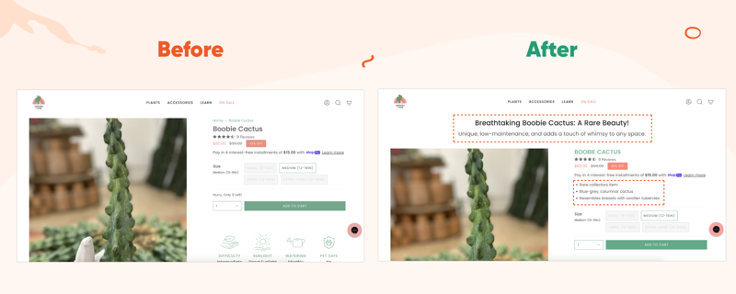
This product page optimization strategy resulted in a 12% increase in orders and an impressive 43% increase in revenue.
FAQ
Is a 1% conversion rate good?
A 1% conversion rate is considered lower than the average rate in ecommerce. It should be improved with some of the conversion rate optimization best practices we discussed in this article.
How to calculate conversion rate?
To calculate your conversion rate, divide the number of conversions by the total number of visitors and multiply by 100. For example, if you have 200 conversions out of 5,000 visitors, your conversion rate is 4%.
What factors can influence my conversion rate?
Several factors can influence your conversion rate, including website design, user experience, content quality, call-to-action clarity, page load speed, and overall trustworthiness of your site.
What is the connection between SEO and CRO?
SEO and CRO are closely intertwined, as SEO works to drive organic traffic to a website, while CRO focuses on converting that traffic into customers or leads. Optimizing the success of a website requires utilizing both strategies together.
Wrapping up
Implementing the 14 conversion rate optimization (CRO) best practices discussed in this blog post can significantly improve your website’s conversion rate and boost online sales.
By focusing on crafting a clear value proposition, writing engaging headlines and copy, and continuously running A/B tests, you can make the most of your website traffic and target qualified leads.
Remember, optimizing your website for conversions is an ongoing process that requires constant monitoring and refining.
By staying up-to-date with the latest CRO best practices and trends, you can ensure your website remains engaging and optimized for your target audience, ultimately leading to increased conversions, sales, and success in the digital landscape.
Migration has never been easier
We made switching a no-brainer with our free, white-glove onboarding service so you can get started in the blink of an eye.

What should you do next?
Thanks for reading till the end. Here are 4 ways we can help you grow your business:
Boost conversions with proven use cases
Explore our Use Case Library, filled with actionable personalization examples and step-by-step guides to unlock your website's full potential. Check out Use Case Library
Create a free OptiMonk account
Create a free OptiMonk account and easily get started with popups and conversion rate optimization. Get OptiMonk free
Get advice from a CRO expert
Schedule a personalized discovery call with one of our experts to explore how OptiMonk can help you grow your business. Book a demo
Join our weekly newsletter
Real CRO insights & marketing tips. No fluff. Straight to your inbox. Subscribe now
Nikolett Lorincz
- Posted in
- Conversion
Partner with us
- © OptiMonk. All rights reserved!
- Terms of Use
- Privacy Policy
- Cookie Policy
Product updates: January Release 2025








